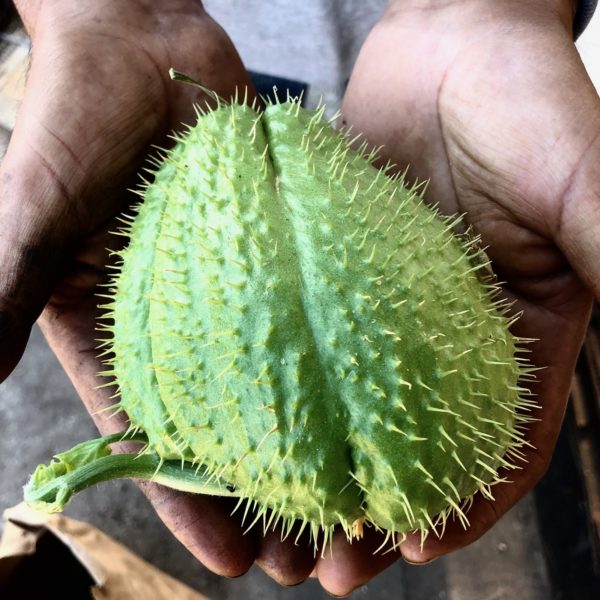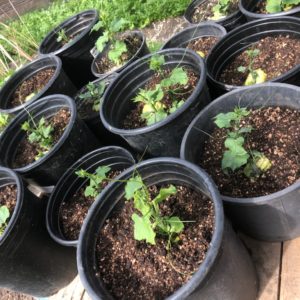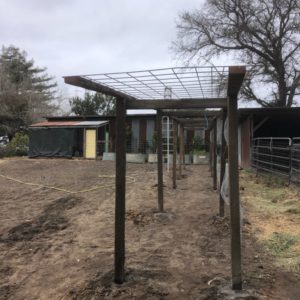Did You Say Chayote?

We’re still seeing rain and cold night temperatures, but spring planting is underway. The potatoes are in the ground, and the basil seed arrived yesterday. Along with corn, squash, tomatoes, chilies and beans, I’ll be trying some chayote this year. Maybe my 2nd time will be the charm.
Several years ago Don Gerardo brought me a chayote from his home in Michoacan and it already had a stem emerging. We planted the fruit at the foot of an Ash tree in my yard and it grew rampantly up into the crown. Eventually, there were some flowers, and then a single fruit formed, but then we had a frost and the whole plant died. This time, I’m thinking that if I plant the Chayote earlier in the year than I did last time it will have more time to set more flowers and create a bigger crop.
 Chayotes are in the squash family, but they behave a little differently than the zucchini. Give it time to grow and the chayote plant will form a large underground potato-like tuber. When a frost kills the foliage, the chayote can always sprout back from the tuber and grow new vines. (I’m also growing the Scarlet runner bean this year, which shares the Chayote’s Central American origin, and it too, develops a tuberous habit. I’m betting the weather is unstable there and it serves the plants well to have a 2nd way of survival if the seed crop can sometimes be destroyed by unpredictable invasion of icy weather.) The habit of the chayote is rampant, clambering over everything in its path, climbing up trees, crawling over walls. It’s the custom in rural Mexico, where the chayote is at home, to let the chayote’s vines scramble into trees. But I don’t want to climb a tree to harvest a squash, so I’ve built some tall frames on the sunny, south side of our home garden for our chayote.
Chayotes are in the squash family, but they behave a little differently than the zucchini. Give it time to grow and the chayote plant will form a large underground potato-like tuber. When a frost kills the foliage, the chayote can always sprout back from the tuber and grow new vines. (I’m also growing the Scarlet runner bean this year, which shares the Chayote’s Central American origin, and it too, develops a tuberous habit. I’m betting the weather is unstable there and it serves the plants well to have a 2nd way of survival if the seed crop can sometimes be destroyed by unpredictable invasion of icy weather.) The habit of the chayote is rampant, clambering over everything in its path, climbing up trees, crawling over walls. It’s the custom in rural Mexico, where the chayote is at home, to let the chayote’s vines scramble into trees. But I don’t want to climb a tree to harvest a squash, so I’ve built some tall frames on the sunny, south side of our home garden for our chayote.
 I’ve got several varieties of Chayote, about fifteen potted plants in all, growing in my greenhouse. When the danger of frost is over, I’ll transplant the chayotes under the frame. As the spring advances into summer the vines will cover the frames like a canopy, and the ripe fruit will hang down through the screen at the top so that it can be picked. Fidel, who manages the production in the greenhouse, gave me the fruits. When the season is over we’ll know if planting them on a larger scale is a good idea. I like the idea that the chayote is popular in South East Asian AND Latin American cooking. I’m going to enjoy getting to know the plant. I’m hoping we’ll have a crop to share by late summer.
I’ve got several varieties of Chayote, about fifteen potted plants in all, growing in my greenhouse. When the danger of frost is over, I’ll transplant the chayotes under the frame. As the spring advances into summer the vines will cover the frames like a canopy, and the ripe fruit will hang down through the screen at the top so that it can be picked. Fidel, who manages the production in the greenhouse, gave me the fruits. When the season is over we’ll know if planting them on a larger scale is a good idea. I like the idea that the chayote is popular in South East Asian AND Latin American cooking. I’m going to enjoy getting to know the plant. I’m hoping we’ll have a crop to share by late summer.
Thanks! Andy
© 2021 Essay and photos by Andy Griffin.


